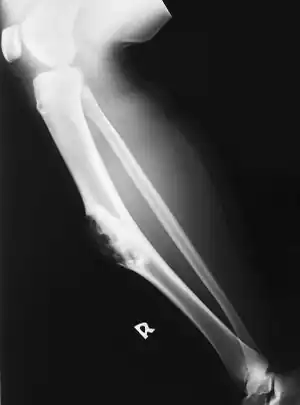Osteofibrous dysplasia
| Osteofibrous dysplasia | |
|---|---|
| Other names: Not recommended: Ossifying fibroma, Kempson-Campanacci lesion.[1] | |
 | |
| Osteofibrous dysplasia of tibia (lower leg) | |
Osteofibrous dysplasia is a noncancerous bone tumor.[1] It most often affects the large long bone of the lower leg in young children.[2][3]
It is considered a fibrovascular defect. Campanacci described this condition in two leg bones, the tibia and fibula,[4] and coined the term.
This condition should be differentiated from fibrous dysplasia of bone[1] and nonossifying fibroma.
.
Signs and symptoms
Osteofibrous dysplasia most often presents as a localized firm painless swelling of the large long bone of the lower leg in young children.[2] The leg may appear bent and it is possible that a break in the bone can occur.[2][5]
Cause
The cause is unknown. Rarely, cases arise in a family.[1]
Diagnosis
Osteofibrous dysplasia may also be mistaken for fibrous dysplasia of bone, although osteofibrous dysplasia is more likely to show an immunohistochemical reaction to osteonectin, neurofibromin 1, and S-100 protein.[5]
Treatment
Generally no treatment is required. Observation is usually recommended and surgery performed if there is a significant bone deformity, severe symptoms, a potential break or a break in the affected bone, or if a definitive diagnosis is required.[1]
Outcomes
Osteofibrous dysplasia may enlarge in children under 10 years and then become smaller or resolve after puberty.[1] That this non-cancerous tumor might progress to adamantinoma is debated. Case studies suggesting a progression generally lack long term follow-up and have sampling issues.[1]
Epidemiology
It is rare, particularly over the age of 15 years.[2] The frequency of occurrence is not known precisely.[2] The tibia accounts for around 90% of cases.[2][6] The long bones of the arm are unlikely to be affected.[2] Boys and girls appear affected equally.[2]
References
- 1 2 3 4 5 6 7 WHO Classification of Tumours Editorial Board, ed. (2020). "Osteofibrous dysplasia". Soft Tissue and Bone Tumours: WHO Classification of Tumours. Vol. 3 (5th ed.). Lyon (France): International Agency for Research on Cancer. pp. 460–462. ISBN 978-92-832-4503-2. Archived from the original on 2021-06-13. Retrieved 2021-05-12.
- 1 2 3 4 5 6 7 8 9 Davies, A. Mark; Sundaram, Murali; James, Steven J. Imaging of Bone Tumors and Tumor-Like Lesions: Techniques and Applications. Springer. p. 420. ISBN 978-3-540-77982-7. Archived from the original on 2021-08-29. Retrieved 2021-05-06.
- ↑ "Bone tumours. What are Bone Tumours?". patient.info. Archived from the original on 24 April 2021. Retrieved 24 April 2021.
- ↑ Campanacci, M. (August 1976). "Osteofibrous dysplasia of long bones a new clinical entity". Italian Journal of Orthopaedics and Traumatology. 2 (2): 221–237. ISSN 0390-5489. PMID 1024109. Archived from the original on 2021-08-29. Retrieved 2021-05-06.
- 1 2 Steven P. Meyers (2008). MRI of bone and soft tissue tumors and tumorlike lesions. Thieme. ISBN 9783131354211. Archived from the original on 2014-07-02. Retrieved 2016-10-28.
- ↑ Robert Mervyn Letts, Osteofibrous Dysplasia, archived from the original on 2010-08-13, retrieved 2009-12-12
External links
- E-medicine overview Archived 2010-08-13 at the Wayback Machine
| External resources |
|---|